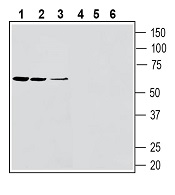Overview
- Peptide CANSSLHDYAKIFP(R), corresponding to amino acid residues 322-335 of human SLC11A1 (Accession P49279). 4th extracellular loop.

 Western blot analysis of rat spleen lysates (lanes 1 and 4), rat lung membranes (lanes 2 and 4) and mouse lung membranes (lanes 3 and 6):1-3. Anti-SLC11A1/NRAMP1 (extracellular) Antibody (#ANT-201), (1:200).
Western blot analysis of rat spleen lysates (lanes 1 and 4), rat lung membranes (lanes 2 and 4) and mouse lung membranes (lanes 3 and 6):1-3. Anti-SLC11A1/NRAMP1 (extracellular) Antibody (#ANT-201), (1:200).
4-6. Anti-SLC11A1/NRAMP1 (extracellular) Antibody, preincubated with SLC11A1/NRAMP1 (extracellular) Blocking Peptide (#BLP-NT201) (#BLP-NT201). Western blot analysis of human THP-1 monocytic leukemia cells:1. Anti-SLC11A1/NRAMP1 (extracellular) Antibody (#ANT-201), (1:200)
Western blot analysis of human THP-1 monocytic leukemia cells:1. Anti-SLC11A1/NRAMP1 (extracellular) Antibody (#ANT-201), (1:200)
2. Anti-SLC11A1/NRAMP1 (extracellular) Antibody, preincubated with SLC11A1/NRAMP1 (extracellular) Blocking Peptide (#BLP-NT201) (#BLP-NT201).
 Expression of NRAMP1 in rat hippocampus.Immunohistochemical staining of perfusion-fixed frozen rat brain sections with Anti-SLC11A1/NRAMP1 (extracellular) Antibody (#ANT-201), (1:600), followed by goat anti-rabbit-Alexa-488. A. Staining in the dentate gyrus region showed NRAMP1 immunoreactivity (green) in the granule layer (G) and in hilar interneurons (arrows). B. Pre-incubation of the antibody with SLC11A1/NRAMP1 (extracellular) Blocking Peptide (#BLP-NT201), suppressed staining. Cell nuclei are stained with DAPI (blue). H = hilus.
Expression of NRAMP1 in rat hippocampus.Immunohistochemical staining of perfusion-fixed frozen rat brain sections with Anti-SLC11A1/NRAMP1 (extracellular) Antibody (#ANT-201), (1:600), followed by goat anti-rabbit-Alexa-488. A. Staining in the dentate gyrus region showed NRAMP1 immunoreactivity (green) in the granule layer (G) and in hilar interneurons (arrows). B. Pre-incubation of the antibody with SLC11A1/NRAMP1 (extracellular) Blocking Peptide (#BLP-NT201), suppressed staining. Cell nuclei are stained with DAPI (blue). H = hilus.
- Blackwell, J.M. et al. (2003) Immunol. Lett. 85, 197.
- Zwilling, B.S. et al. (1999) Infect. Immunol. 67, 1386.
- Goswami, T. et al. (2001) Biochem. J. 354, 511.
- Qi, H. et al. (2014) Spectrochim. Acta A Mol. Biomol. Spectrosc. 122, 82.
Solute carrier family 11 member a1 (Slc11a1) also known as natural resistance-associated macrophage protein 1 (NRAMP1) is a proton/divalent cation antiporter, known for its role in regulating the antimicrobial activity of macrophages1. The structure of Slc11a1 includes a common and conserved hydrophobic core of 10 transmembrane domains (TM) and either one or two non-conserved, highly hydrophobic TM domains4.
Slc11a1 delivers divalent cations such as Fe2+, Zn2+, and Mn2+ from the cytosol to the late endosome/lysosome acidic compartments where the Fenton reaction can use ferrous iron to generate toxic hydroxyl radicals2. Thus, providing one mechanism by which Slc11a1 could influence antimicrobial activity in macrophages.
Transition of metal ions is essential and participates in numerous cellular functions such as regulation of transcription. In addition, hundreds of enzymes require metal ions as co-factors3.
Studies show that polymorphism in SLC11A1 is correlated to the occurrence of autoimmune and infectious disease susceptibility, as well as innate and adaptive immune responses to mycobacterial products/antigens. Therefore, research on this ion transporter is of high importance1.
Application key:
Species reactivity key:
Anti-SLC11A1/NRAMP1 (extracellular) Antibody (#ANT-201) is a highly specific antibody directed against an epitope of the human protein. The antibody can be used in western blot and indirect live cell flow cytometry applications. It has been designed to recognize NRAMP1 from rat, mouse, and human samples.

